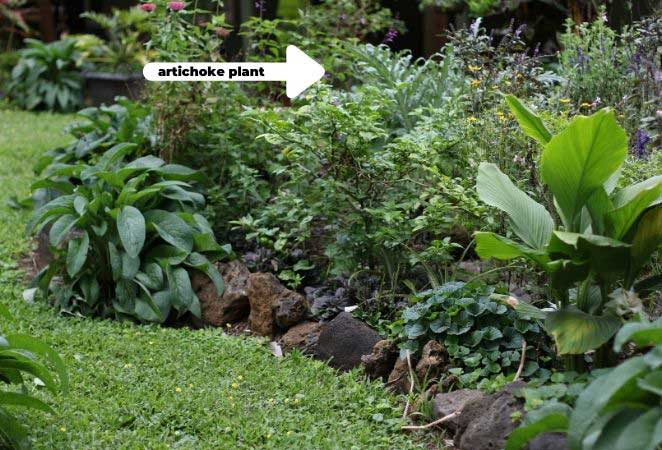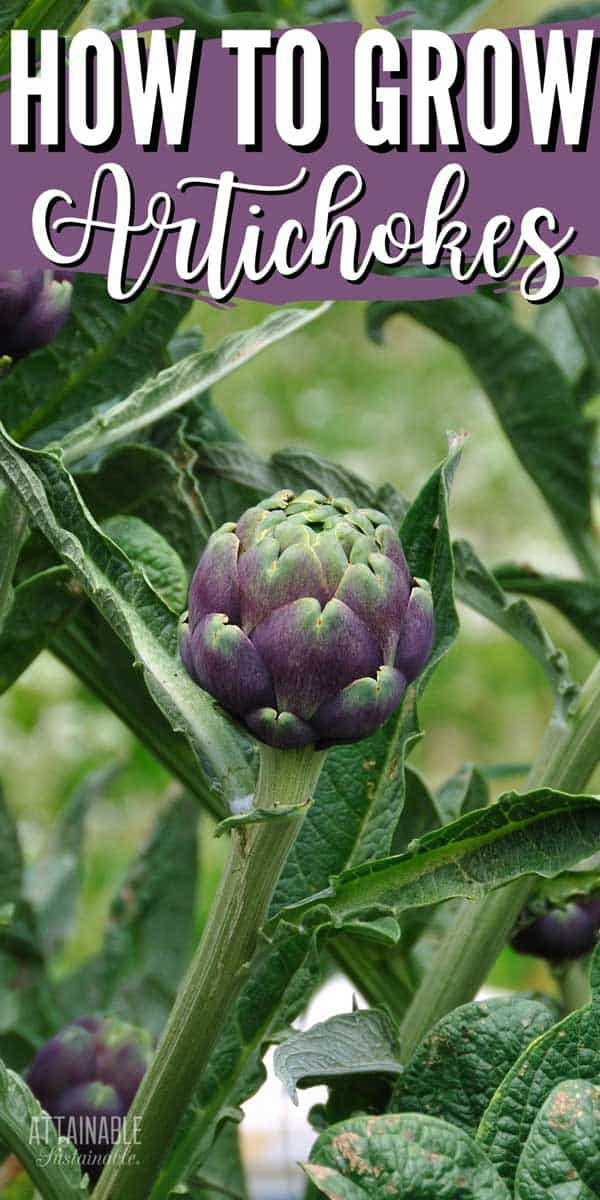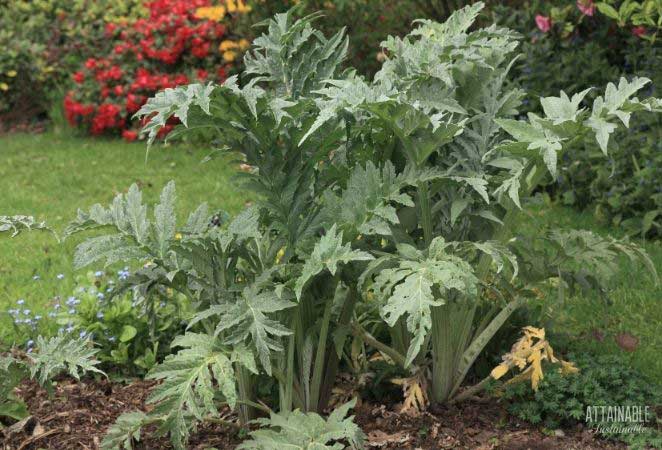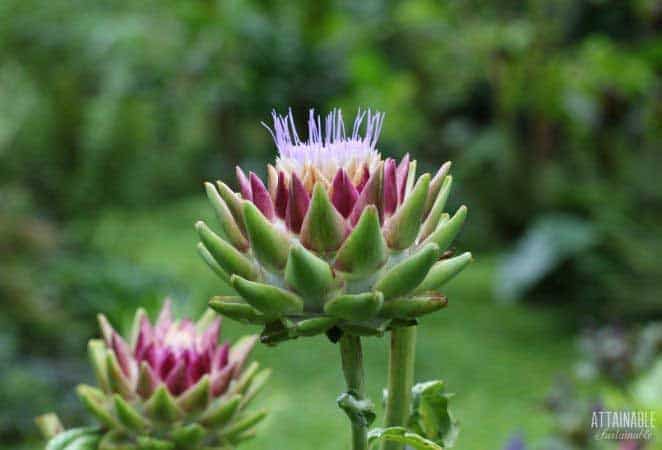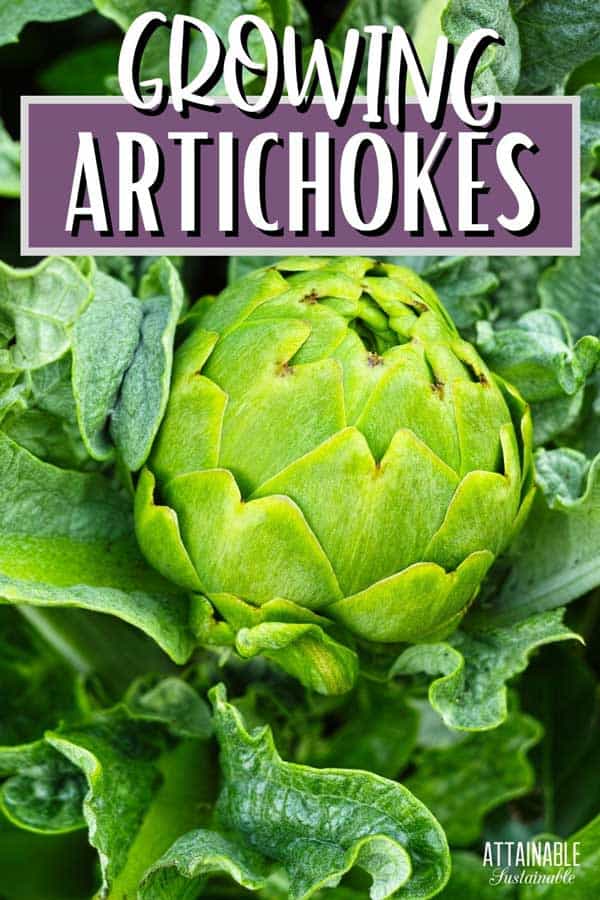Growing artichokes in your home garden allows you to enjoy these unusual — and sometimes expensive — vegetables harvested fresh from the plant. And this perennial crop can be a stealthy addition to an edible garden!
Contributed by Jodi Torpey in March 2021; this post has been updated.
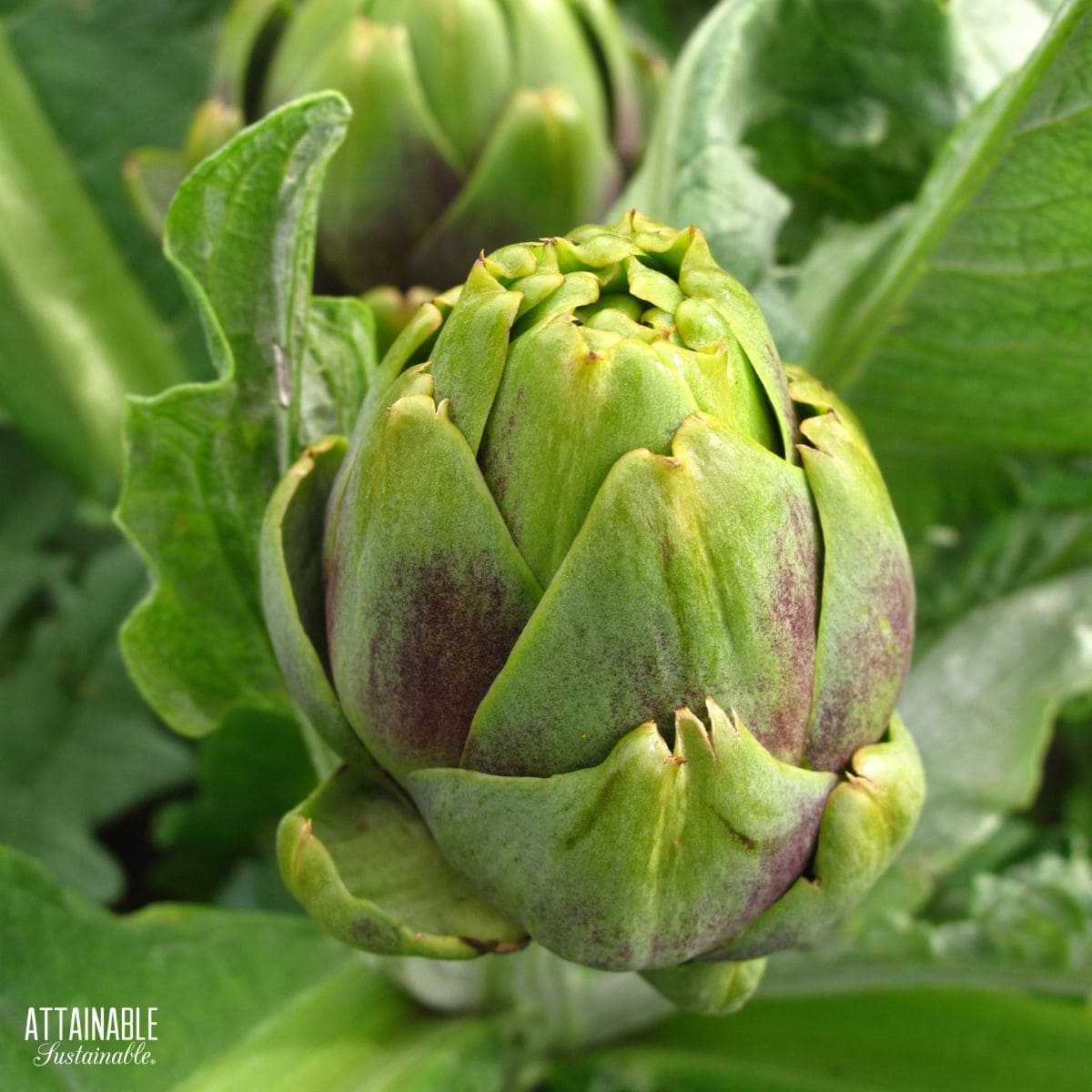
Artichokes are actually the edible flower bud of a thistle-like plant. Left unharvested (as above) the eye-catching flowers attract bees to the garden. These ancient and unusual edibles can add a striking architectural feature to either your vegetable bed or ornamental garden.
Some vegetable historians believe artichokes originated in the Mediterranean region, and were one of the most prized vegetables in Roman times.
All About Artichokes
There are three unrelated plants that are called artichokes. Globe artichokes (Cynara scolymus) are the ones we’re most familiar with. The name is also shared with sunchoke and Chinese or Japanese artichokes.
Grow Some Greens!
Ready to grow fresh greens, no matter WHERE you live? Sign up for my
FREE quick-start guide and start growing some of your own food!
There are many varieties of globe artichokes for gardeners to grow. The edible flower buds grow on sturdy stalks with a primary bud at the tip and several smaller buds that grow lower on the stalk. The edible flower has tough, petal-shaped leaves that can be prepared for eating in different ways.
There are size differences in artichokes, from baby-sized to jumbo, and they come in several colors, too.
In cool climates, select the globe artichoke varieties that can mature in 85-95 days. Warmer regions can plant for a longer gardening season. Some varieties can be perennial in hardiness zones above 6 or 7.
Three Popular Artichoke Varieties to Grow
Green globe is the standard artichoke that most gardeners grow. The dark green flow buds have a slight purple coloring on 3-4 good sized heads; hardy in zone 7 and above.
Violetto gets its name from its violet coloring. The small oval, flower heads make for good eating; hardy to zone 6 and above.
Imperial Star is a perfect artichoke for gardeners who want to grow their plants as annuals. These plants produce more than 6 buds each, 3-4 inches in diameter; hardy in regions above zone 7.
Growing Artichokes from Seed
Artichokes are surprisingly easy to grow from seeds, though you’ll need to start them indoors before you plant them out into the garden.
Start artichoke seeds indoors early in the season, sowing several seeds in small pots 8-10 weeks before you want to transplant them outside. An alternative is to purchase artichoke transplants from a garden center or vegetable plant catalog.
To decide how many artichoke plants to start, consider a typical harvest is about 3-5 artichokes per plant. You’ll need a large, sunny space in the garden because plants can grow to 3-5 feet wide and just as tall. They can do well in raised beds, but being mindful of how much space they require is important.
Place artichoke transplants that have about 7 leaves into the garden when soil has warmed to between 45-65 degrees. Timing should be after the last frost date, but while air temperatures are still below 50 degrees for around two weeks to help induce budding.
This process is called vernalization and it signals a perennial plant to start its reproductive phase. A brief cold period of time encourages artichoke plants to start to form the all-important flower buds so you’ll have a crop the first year.
Space plants about 48 inches apart in rows; space rows at least 80 inches apart for best results. You can also sprinkle plants throughout the ornamental garden or in a raised bed to add vertical interest.
Add a thick layer of organic mulch, like untreated grass clippings or straw, to prevent weeds from sprouting.
Requirements for Growing Artichokes
Light requirements
Plant artichoke seedlings in full sun, but be prepared to give them some shade in areas with high heat and bright sunlight.
Soil requirements
Cultivate the soil deeply so plants can spread their roots, and amend the soil with compost or other organic matter to build a rich, fertile loam that’s well-drained. Artichoke plants don’t grow well in heavy soils, like clay, or soils that drain slowly. Plants won’t grow well in water-logged soils.
Water and Fertilizer Requirements
Because artichokes are heavy nitrogen feeders, make sure to keep up with fertilizer throughout the growing season. It’s important for plants to get regular, deep watering, especially when flower buds are forming.
Pest Control and Diseases
Keep an eye on your artichoke plants to catch any issues quickly. Here are some insect pests and diseases to watch for:
When aphids start to show up, spray them off with strong blasts of water from the hose. Make sure to get under plant leaves and keep up the spraying until they’re no longer a problem.
Earwigs like to hide in newly formed flower buds. Prevent them by setting out earwig traps, like rolled up newspaper on the ground, before plants begin to form flower buds.
Snails and slugs can feed on leaves during the night, leaving large holes in leaves. Set out beer traps by sinking a container with vertical sides so only one inch of the rim is above the soil. Fill with 1 inch of beer to attract and then drown slugs.
Bacterial wilt and Verticillium wilt can cause plants to suddenly wilt, even when soil is moist. Remove the infected plants and discard. Widely spacing plants and overwatering can help prevent problems with wilt.
Avoid regular overhead watering, which can cause conditions that help powdery mildew thrive.
Growing Artichokes in Pots
Artichokes can make for an interesting container plant either alone or as part of a combination planting. The tall stems would be the thriller and you can add the spillers and fillers.
Choose a large container that’s at least 12 inches deep. Fill with good potting soil mixed with compost in equal amounts. This combination helps give plants the soil fertility they need to grow in containers.
Make sure the container drains well and avoid overwatering plants through the season. Harvest the flower buds while they’re still tight by cutting them from the stem.
In some areas, you may be able to move the container into a garage or shed to overwinter, as long as temperatures don’t go below 25 degrees Fahrenheit.
Otherwise, plan on growing your artichokes as a beautiful and delicious annual instead of a perennial.
Harvesting Artichokes
Cut the flower buds before they start to open for the best taste. A primary flower bud will form at the top of the stalk with 2 or more smaller buds on side shoots.
Artichokes are ready to harvest when the flower bud has a tight leaf formation, deep color and feels heavy for its size. If in doubt, the leaves should squeak when pressed together.
Cut the artichoke stem straight across, leaving about 2 inches of stem below the flower bud’s base. Enjoy as close to harvest as possible or store (unwashed) in plastic bags in the fridge for up to 4 days.
Using Artichokes in Cooking
Artichokes are delicious whether steamed, grilled or baked. Store fresh unwashed artichokes in the refrigerator in plastic bags and wash just before preparing them. Artichokes are usually cooked whole with the base and top leaves neatly trimmed with scissors or a knife. After cooking, remove the fuzzy interior with a spoon and discard.
When grilling, the artichoke can be cut in half and placed directly on the grill.
Steamed artichokes are served with a lemon butter dip. Some gardeners think the tender base is the best part of growing, cooking and eating artichokes.
Overwintering Artichokes
In warmer regions, artichokes can survive the winter. Cut back plants to about 8 inches above the ground and mulch with clean straw or other mulch to protect the crown of the plant. If temperatures dip below 25 degrees Fahrenheit, crowns may not make it through the cold.
Need more ideas for sneaking vegetables into a pretty front yard garden? This will help you fool the Homeowners Association!

